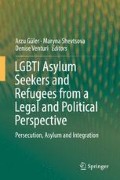Abstract
Lesbian and gay (LG) identified asylum seekers are caught having to play out both covering and reverse-covering processes in the United States: they first faced the necessity of attempting to cover in their country of origin where they experienced discrimination and persecution if their sexual orientation was known, but when applying for asylum, they must reverse-cover so as to prove their sexual orientation to the immigration judge. This chapter examines the psychological implications of the reverse covering demand on LG asylum seekers, asserting that the immigration judges’ perceived expectation that these individuals be out regarding their sexual orientation identity at the time of the asylum interview can produce negative mental health effects. Findings from a qualitative research study conducted by the author concerning the experiences of 15 LG individuals seeking asylum in the United States due to persecution in their country of origin as a result of their sexual orientation are used to ground this idea. Six recommendations are provided for immigration judges regarding how to avoid perpetuating a reverse-covering demand and consequent potential negative mental health effects by means of improved education on how to conduct better LG-informed interviews.
Access this chapter
Tax calculation will be finalised at checkout
Purchases are for personal use only
Notes
- 1.
“The Psychological Impact of the Asylum-Seeking Process in the United States on Individuals Who Identity as Lesbian, Gay Male, or Bisexual: A Qualitative Study” Long Island University. Defended April, 21, 2016.
- 2.
One of the subjects initially identified himself as bisexual and later in the interview stated that he actually identifies as gay. This chapter intentionally focused on the experiences of the lesbian and gay subjects for purposes of focus and space. Not wanting to contribute to a “bi bias” where bisexual individuals are excluded, further study and attention to this particular population and its specific concerns and needs is highly encouraged.
References
Auerbach, C. F., & Silverstein, L. B. (2003). Qualitative data: An introduction to coding and analysis. New York: New York University Press.
Berger, S. A. (2009). Legal discourses of asylum in the United States. Journal of Women in Culture and Society, 24, 659–685.
Cass, V. C. (1979). Homosexual identity formation: A theoretical model. Journal of Homosexuality, 4(3), 105–126.
De Monteflores, C., & Schultz, S. J. (1978). Coming out: Similarities and differences for lesbians and gay men. Journal of Social Issues, 34, 59–71.
Goffman, E. (1963). Stigma: Notes on the management of spoiled identity. Prentice-Hall.
Heller, P. (2009). Challenges facing LGBT asylum-seekers: The role of social work in correcting oppressive immigration processes. Journal of Gay & Lesbian Social Services, 21, 294–308.
Hopkinson, R. A., Keatley, E., Glaeser, E., Erickson-Schroth, L., Fattal, O., & Sullivan, M. N. (2017). Persecution experiences and mental health of LGBT asylum seekers. Journal of Homosexuality, 64, 1650–1666.
Kaufman, J., & Johnson, C. (2004). Stigmatized individuals and the process of identity. The Sociological Quarterly, 45, 807–833.
Kimmel, M., & Llewellyn, C. (2012). Homosexuality, gender noncomformity, and the neoliberal state. Journal of Homosexuality, 59, 1087–1094.
Mays, V. M., & Cochran, S. D. (2001). Mental health correlates of perceived discrimination among lesbian, gay, and bisexual adults in the United States. American Journal of Public Health, 91, 1869–1876.
Meyer, I. H. (2003). Prejudice, social stress, and mental health in lesbian, gay, and bisexual populations: Conceptual issues and research evidence. Psychological Bulletin, 129, 674–697.
National Coalition of Anti-Violence Programs. (2017). National Report on Hate Violence Against Lesbian, Gay, Bisexual, Transgender, Queer and HIV-Affected Hate Violence in 2016. Retrieved August 25, 2017 from http://avp.org/wp-content/uploads/2017/06/NCAVP_2016_HVReport_Media-Release.pdf
National Institute of Mental Health. (2016). Depression. Retrieved December 3, 2017, from https://www.nimh.nih.gov/health/topics/depression/index.shtml
Pachankis, J. E., Cochran, S. D., & Mays, V. M. (2015). Mental health of sexual minority adults in and out of the closet: A population-based study. Journal of Consulting and Clinical Psychology, 83, 890–901.
Pistella, J., Salvati, M., Ioverno, S., Laghi, F., & Baiocco, R. (2016). Coming-out to family members and internalized sexual stigma in bisexual, lesbian, and gay people. Journal of Child and Family Studies, 25, 3694–3701.
Ray, N. (2006). Lesbian, gay, bisexual and transgender youth: An epidemic of homelessness. New York: National Gay and Lesbian Task Force Policy Institute and the National Coalition for the Homeless.
Roberts, A., Austin, B., Corliss, H., & Vandermorris, A. (2010). Pervasive trauma exposure among US sexual orientation minority adult and risk of posttraumatic stress disorder. American Journal of Public Health, 100, 2433–2441.
Ryan, W. S., Legate, N., & Weinstein, N. (2015). Coming out as lesbian, gay, or bisexual: The lasting impact of initial disclosure experiences. Self and Identity, 14, 549–569.
U.S. Citizenship and Immigration Services. (2017). Obtaining Asylum in the United States. Retrieved October 16, 2017, from https://www.uscis.gov/humanitarian/refugees-asylum/asylum/obtaining-asylum-united-states
Yoshino, K. (2006). Covering: The hidden assault on our civil rights. New York: Random House.
Author information
Authors and Affiliations
Corresponding author
Editor information
Editors and Affiliations
Rights and permissions
Copyright information
© 2019 Springer Nature Switzerland AG
About this chapter
Cite this chapter
Berasi, K. (2019). Gay and Lesbian Asylum Seekers in the United States: The Interplay of Sexual Orientation Identity Development, Reverse-Covering, and Mental Health. In: Güler, A., Shevtsova, M., Venturi, D. (eds) LGBTI Asylum Seekers and Refugees from a Legal and Political Perspective. Springer, Cham. https://doi.org/10.1007/978-3-319-91905-8_11
Download citation
DOI: https://doi.org/10.1007/978-3-319-91905-8_11
Published:
Publisher Name: Springer, Cham
Print ISBN: 978-3-319-91904-1
Online ISBN: 978-3-319-91905-8
eBook Packages: Law and CriminologyLaw and Criminology (R0)

